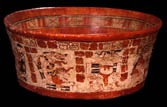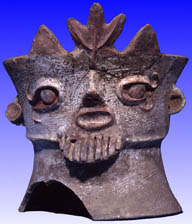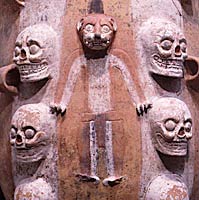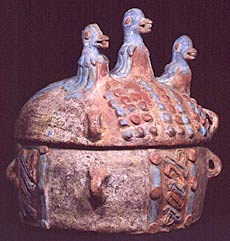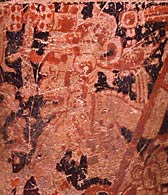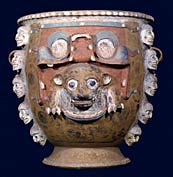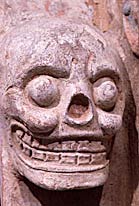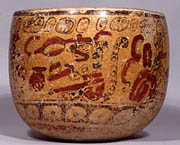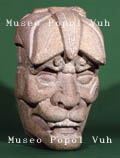These page feature archaeology information and Images of pre-Columbian Maya art from the Museo Popol Vuh. The purpose of this section of the FLAAR Maya archaeology web sites is to draw attention to the museums of Guatemala to encourage more people to visit them.
 |
|---|
To appreciate the genius of the Classic Maya artists and scribes, a visit to the Museo Popol Vuh is essential. Although 90% of the visitors to Guatemala visit Antigua or Chichicastenango, and perhaps 50% visit Tikal, too few reach the museums. The exhibits are well designed in a modern manner. The building is new and looks suitably impressive.The exhibits include a colorful display of animals in Maya art. In addition to pre-Columbian art, the museum has a really nice selection of Spanish colonial art.
Known as the "Man from Mars," this effigy with the distorted lips is typical of the Highland Maya of Guatemala. Lots of Maya faces of this area have the fat lips. Does this really mean they are from Africa? Scholars debate this topic with popular writers who promote trans-oceanic contact. The chimney in the back of the skull does not mean this character is from Outer Space either.
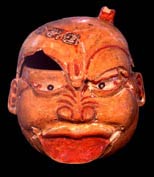 |
|---|
|
Ceramic effigy of a distorted face, Chama style and colors, Highlands, A.D. 700-800.
|
Notice the board nose and possible scarification in addition to the wide mouth with thick lips.Two more effigies of this style are in the basement storage of the museum. These other two, however, are not brightly painted.
This distorted face is over a thousand years old. It was made in the Chama area of the Guatemalan Highlands, and is now a prize exhibit of the Popol Vuh archaeology museum on the campus of the Universidad Francisco Marroquin in Guatemala City.
Chama art can be distinguished by its special kind of orange color and by the shape, design, and colors of the Mayan hieroglyphs. Chama style hieroglyphs can easily be distinguished from glyphs of the same period from 100 miles to the north, in the Peten area.How do epigraphers figure out who wrote these ancient inscriptions?
You can come to the annual epigraphy discussion group and learn how to read these yourself. We provide patient instruction.If you are curious on how to learn to distinguish Chama art from Peten art, we offer courses on this as well.
If you want to go to Guatemala with Professor Hellmuth, and see how he does all this with the actual pots, you can sign up to go along on an archaeology expedition with him. People from ages 7 to 78 have enjoyed learning about archaeology on one of his seminars in Guatemala, Belize, Mexico, or Honduras.
If your school studies include the Maya in Social Sciences, Humanities, Visual Arts, History, Anthropology, or related topics, you can bring Professor Hellmuth to your home town for a slide lecture right in your own school.

